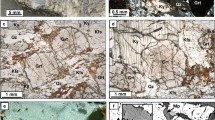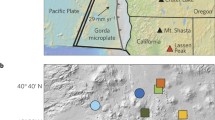Abstract
Two metamorphic processes, i.e. subsolidus dehydration and partial melting occurring in MORB, metasediments and peridotite of subducted oceanic lithosphere are discussed on the basis of available experimental work and phase equilibrium modeling. Phase diagrams of hydrous MORB show that in most cold subduction P-T (pressure-temperature) regimes a large portion of water in the basic layer has released below the onset of blueschist facies (< 20 km), and at a depth (60–70 km) of transition from lawsonite blueschist to lawsonite eclogite facies through glaucophane dehydration; only a smaller portion of water will escape from the slab through dehydration of lawsonite and chloritoid in the depth range suitable for arc magma formation; and a very small portion of water stored in lawsonite and phengite will fade into the deeper mantle. The role of amphibole for arc magma formation is still arguable. In cold subduction P-T regimes, the dehydration of chlorite and talc in Al-poor metasediments, and chloritoid and carpholite in Al-rich metapelites at a depth around 80–100 km will make some contributions to the formation of arc magma. Comparatively, dehydration of serpentine in hydrated peridotite occurs at depths of 120–180 km, playing an important role in the arc magmatism. Subduction of oceanic crust along warm P-T regimes will cross the solidi at a depth over 80 km, resulting in partial melting under fluid-saturated and fluid-absent conditions in the metasediments involving biotite and phengite, and in the basic rocks involving epidote and amphibole. The melt compositions of the basic crust are adakitic at pressures < 3.0 GPa, but become peraluminous granitic at higher pressures.
Similar content being viewed by others
References
Poli S, Schmidt M W. Petrology of subducted slabs. Ann Rev Earth Planet Sci, 2002, 30: 207–235
Schmidt M W, Vielzeuf D, Auzanneau E. Melting and dissolution of subducting crust at high pressures: the key role of white mica. Earth Planet Sci Lett, 2004, 228: 65–84
Nicolas A. Structures of Ophiolites and Dynamics of Oceanic Lithosphere. Dordrecht: Kluwer Academic Publishers, 1989. 367
Peacock S M, Wang K. Seismic consequences of warm versus cool subduction metamorphism: examples from Southwest and Northeast Japan. Science, 1999, 286: 937–939
Kirby S H. Taking the temperature of slabs. Nature, 2000, 403:31–34
Schmidt M W. Lawsonite: upper pressure stability and formation of higher density hydrous phases. Am Mineral, 1995, 80: 1286–1292
Schmidt M W, Poli S. The stability of lawsonite and zoisite at high pressures: experiments in CASH to 92 kbar and implications for the presence of hydrous phases in subducted lithosphere. Earth Planet Sci Lett, 1994, 124: 105–118
Poli S, Schmidt MW. H2O transport and release in subduction zones: experimental constraints on basaltic and andesitic systems. J Geophys Res, 1995, 100: 22299–22314
Schmidt M W, Poli S. Experimentally based water budgets for dehydrating slabs and consequences for arc magma generation. Earth Planet Sci Lett, 1998, 163: 361–379
Peacock S M. The importance of blueschist to eclogite dehydration reactions in subducting oceanic crust. Geol Soc Am Bull, 1993, 105:684–694
Sorensen S S. Petrologic and geochemical comparison of the blueschist and greenschist units of the Catalina schist terrane, southern California. In: Evans B W, Brown E H, eds. Blueschists and Eclogites. Geol Soc Am Mem 164, 1986. 59–75
Schmidt M W, Poli S. Generation of mobile components during subduction of oceanic crust. Treatise Geochem, 2003, 3: 567–591
Schmidt MW. Experimental constraints on recycling of potassium from subducted oceanic crust. Science, 1996, 272: 1927–1930
Oh C W, Liou J G. A petrogenetic grid for eclogite and related facies under high-pressure metamorphism. The Island Arc, 1998, 7: 36–51
Davies J H, Stevenson D J. Physical model of source region of subduction zone volcanic. J Geophys Res, 1992, 97: 2037–2070
Hermann J, Green D H. Experimental constraints on high pressure melting in subducted crust. Earth Planet Sci Lett, 2001, 188:149–168
Chopin C. Talc-phengite: a widespread assemblage in high-grade pelitic blueschists of the western Alps. J Petrol, 1981, 22: 628–650
Schreyer W. Experimental studies on metamorphism of crustal rocks under mantle pressures. Mineral Mag, 1988, 52: 1–26
El-Shazly A K, Liou J G. Glaucophane chloritoid-bearing assemblages from NE Oman: petrologic significance and a petrogenetic grid for high-P metapelites. Contrib Mineral Petrol, 1991, 107: 180–201
Theye T, Seidel E, Vidal O. Carpholite, sudoite and chloritoid in low-grade high-pressure metapelites from Crete and the Peloponnese, Greece. Euro J Mineral, 1992, 4: 487–507
Wei C J, Song S G. Chloritoid-glaucophane schist in the north Qilian orogen, NW China: Phase equilibria and P-T path from garnet zonation. J Metamorphic Geol, 2008, 26: 301–316
Spear F S. Metamorphic Phase Equilibria and Pressure-Temperature-Time Paths. Washington D C: Mineral Soc Ame, 1993. 337–392
Wei C J, Powell R. Phase relations in high-pressure metapelites in the system KFMASH (K2O-FeO-MgO-Al2O3-SiO2-H2O) with application to natural rocks. Contrib Mineral Petrol, 2003, 145: 301–315
Wei C J, Powell R, Zhang L F. Eclogites from the south Tianshan, NW China: petrological characteristic and calculated mineral equilibria in the Na2O-CaO-FeO-MgO-Al2O3-SiO2-H2O system. J Meta Geol, 2003, 21: 163–180
Nichols G T, Wyllie P J, Stern Ch R. Subduction zone melting of pelagic sediments constrained by melting experiments. Nature, 1994, 371: 785–788
Ulmer P, Trommsdorff V. Phase relations of hydrous mantle subducting to 300 km. In: Fei Y W, Bertka C, Mysen B O, eds. Mantle Petrology: Field Observations and High Pressure Experimentation: A Tribute to Francis R. (Joe) Boyd. Geochem Soc Spec Publ, 1999. 6:259–281
Wunder B. Equilibrium experiments in the system MgO-SiO2-H2O (MSH): stability fields of clinohumite-OH [Mg9Si4O16(OH)2], chondrodite-OH [Mg5Si2O8(OH)2] and phase A (Mg7Si2O8(OH)6). Contrib Mineral Petrol, 1998, 132: 111–120
Ulmer P, Trommsdorff V. Serpentine stability to mantle depths and subduction related magmatism. Science, 1995, 268: 858–861
Fumagalli P, Stixrude L, Poli S, et al. The 10A phase: a high-pressure expandable sheet silicate stable during subduction of hydrated lithosphere. Earth Planet Sci Lett, 2001, 186: 125–141
Kawamoto T, Hervig R L, Holloway J R. Experimental evidence for a hydrous transition zone in the early Earth’s mantle. Earth Planet Sci Lett, 1996, 143: 587–592
Fumagalli P, Poli S. Phase relationships in hydrous peridotites at high pressure: preliminary results of multianvil experiments. Period Mineral, 1999, 68: 275–286
Spear F S, Kohn M J, Cheney J T. P-T paths from anatectic pelites. Contrib Mineral Petrol, 1999, 134: 17–32
White R W, Powell R, Holland T J B. Calculation of partial melting equilibria in the system Na2O-CaO-K2O-FeO-MgO-Al2O3-SiO2-H2O (NCKFMASH). J Meta Geol, 2001, 19: 139–153
Domanik K J, Holloway J R. The stability and composition of phengitic muscovite and associated phases from 5.5 to 11 GPa: Implications for deeply subducted sediments. Geochim Cosmochim Acta, 1996, 60: 4133–4150
Vielzeuf D, Schmidt M W,. Melting relations in hydrous systems revisited: application to metapelites, metagreywackes and metabasalts. Contrib Mineral Petrol, 2001, 141: 251–267
Green D H, Ringwood A E. An experimental investigation of the gabbro to eclogite transformation and its petrological applications. Geochim Cosmochim Acta, 1967, 31: 767–833
Vielzeuf D, Holloway J R. Experimental determination of the fluidabsent melting relations in the pelitic system. Contrib Mineral Petrol, 1988, 98: 257–276
Ono S. Stability limits of hydrous minerals in sediment and mid-ocean ridge basalt compositions: implications for water transport in subduction zones. J Geophy Res, 1998, 103: 18253–18267
Irifune T. Absence of an aluminous phase in the upper part of the Earth’s lower mantle. Nature, 1994, 370: 131–133
Winther K T, Newton R C. Experimental melting of hydrous low-K tholeiite: evidence on the origin of Archean cratons. Bull Geol Soc Denmark, 1991, 39: 497–515
Wyllie P J, Wolf M B. Amphibolite dehydration melting: sorting out the solidus. In: Prichard H M, Alabaster T, Harris N B W, et al., eds. Magmatic Processes and Plate Tectonics. London: Geol Soc Spec Publ, 1993. 76: 405–416
Morris J D, Leemann W P, Tera F. The subducted component in island arc lavas: constraints from Be isotopes and B-Be systematic. Nature, 1990, 344: 31–36
Sigmarsson O, Condomines M, Morris J D, et al. Uranium and 10Be enrichments by fluids in the Andean arc magmas. Nature, 1990, 346:163–165
Plank T, Langmuir C H. Tracing trace elements from sediment input to volcanic output at subduction zones. Nature, 1993, 362: 739–743
Gill J. Orogenic Andesites and Plate Tectonics. New York: Springer, 1980. 390
Tatsumi Y. Formation of the volcanic front in subduction zones. Geophys Res Lett, 1986, 17: 717–720
Mottana A, Carswell D A, Chopin C, et al. Eclogite facies mineral parageneses. In: Carswell D A, eds. Eclogite Facies Rocks. New York: Blackie and Son Ltd, 1990. 14–52
Wei C J, Powell R. Calculated phase relations in high-pressure metapelites in the system NKFMASH (Na2O-K2O-FeO-MgO-Al2O3-SiO2-H2O) with application to natural rocks. J Petrol, 2004, 44: 183–202
Yang J J, Powell R. Calculated phase relations in the system Na2O-CaO-K2O-FeO-MgO-Al2O3-SiO2-H2O with applications to UHP eclogites and whiteschists. J Petrol, 2006, 47: 2047–2071
Wei C J, Yang Y, Su X L, et al. Metamorphic evolution of low-T eclogite from the north Qilian orogen, NW China: Evidence from petrography and calculated phase equilibria in system NCKFMASHO. J Meta Geol, Submitted.
Okamoto K, Maruyama S. The high-pressure synthesis of lawsonite in the MORB-H2O system. Am Mineral, 1999, 84: 362–373
Perfit M R, Gust D A, Bence A E, et al. Chemical characteristics of island-arc basalts: implications for mantle sources. Chem Geol, 1980, 30: 227–256
Kay R W. Volcanic arc magmas: implications of a melting-mixing model for element recycling in the crust-upper mantle system. J Geol, 1980, 88: 497–522
McCulloch M T, Gamble J A. Geochemical and geodynamical constraints on subduction zone magmatism. Earth Planet Sci Lett, 1991, 102: 358–374
Johnson M C, Plank T. Dehydration and melting experiments constrain the fate of subducted sediments. Geochem Geophys Geosyst, 1 Electron J, 1999, 1, paper no. 1999GC000014
Ryan J G, Morris J, Tera F, et al. Cross-arc geochemical variations in the Kurile arc as a function of depth. Science, 1995, 270: 625–627
Martin H. Adakitic magmas: modern analogues of Archean granitoids. Lithos, 1999, 46: 411–429
Foley S. Petrological characterization of the source components of potassic magmas: Geochemical and experimental constraints. Lithos, 1992, 28: 187–204
Author information
Authors and Affiliations
Corresponding author
Additional information
Supported by National Natural Science Foundation of China (Grant No. 40525006)
About this article
Cite this article
Wei, C., Zhang, Y. Phase transition in the subducted oceanic lithosphere and generation of the subduction zone magma. Chin. Sci. Bull. 53, 3603–3614 (2008). https://doi.org/10.1007/s11434-008-0405-3
Received:
Accepted:
Published:
Issue Date:
DOI: https://doi.org/10.1007/s11434-008-0405-3




